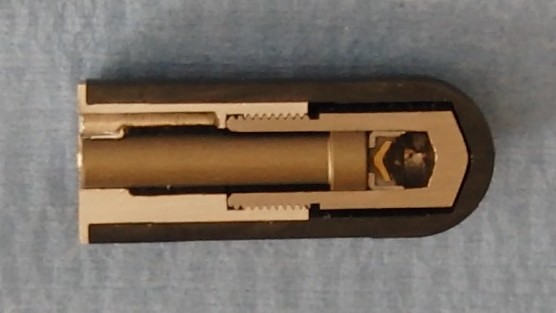This New Non-Lethal Gun Could Be More Effective Than Police Tasers
It stops the target without harming them.
A
new compact, lightweight weapon will stop a target in their tracks from
a hundred meters away without harming them. Nicknamed the Pogojet, it's
a radical less-than-lethal design from Jeffrey Widder, senior research
scientist at Battelle Memorial Institute in Ohio.
The
Pogojet—whose official name is the Caseless Telescoping Less-lethal
System—is unique in that the propellant burns inside the round, pushing
on a piston that propels it forward. The action resembles a pogo stick,
hence the name. Once the piston reaches its full extent, the exhaust
gases can be vented sideways, so the round continues forward at the same
speed, or directed through holes in the base of the round like rocket
exhaust to give as much extra kick as required. This is the 'jet' aspect
of the Pogojet, which Widder compares to the old 1960s Gyrojet rocket pistol.
Smart Bullets
It's
a clever design meant to get around a pesky problem. Conventional
wisdom says that the non-lethal rounds used to stun suspects need to be
big, soft, and slow. Think of the bean bag rounds fired from police
shotguns, the 40mm sponge grenades used by the military, and traditional
"rubber bullets." Their low velocity gives them a shorter range than a
thrown rock—a serious disadvantage when facing rioters.
The
other challenge with less-lethal impact weapons is balancing
effectiveness with safety. A round that travels slowly enough to be safe
at point-blank range is ineffective at long range. Increase the muzzle
velocity to knock down a target further away and the weapon becomes
potentially deadly when used up close.
Widder's
challenge was to find a way of varying the muzzle velocity depending on
the distance to the target so that the projectile always hits at the
sweet spot of between 77 and 87 meters per second. His final design uses
a small .50 caliber weapon firing a hard projectile that uses that gas
venting strategy to hit the target at optimal speed. This variable speed
makes the Pogojet safe at short range and effective at long range.
Widder says it will be effective at a hundred meters, far further than
any existing kinetic round.
"Once
the gas comes out it can be throttled," said Widder. "The technical
challenge turned out to be remarkably simple. Once I'd figured it out I
didn't know why I found it so difficult."
The
Pogojet will use a laser rangefinder—technology that already exists for
small arms, but is mainly used with military grenade launchers. The
Pogojet will interface with a rangefinder to ensure that the right
muzzle velocity is automatically selected without any manual control.
Building the interface is one of the next steps in the project. But the
key element, the variable velocity system, has already proven highly
reliable.
Widder's
design has another advantage in that it produces enough pressure to
work as a semi-automatic, unlike the pump-action bean-bag shotguns.
Unlike other less-lethals, the Pogojet can be fired as rapidly as
needed, so the shooter can get off another shot if they miss the target.
The
piston arrangement also means even a very short barrel is enough for
high velocity and accuracy, making the Pogojet more compact than the
alternatives. Widder imagines the weapon fitted as an under-barrel extra
to an M4 carbine, giving soldiers a simple, long-range, multi-shot
alternative to lethal rounds. The Pogojet might also be used separately
as a pistol, without the rangefinder and set to the lowest velocity. It
could still be effective out to fifty meters, compared to twenty meters
maximum for a bean bag gun and even less for a Taser, giving cops an easily portable alternative.
Sting Like a Bee
Most
non-lethal kinetic rounds are designed to flatten on impact and spread
the blow over a large area. This improves safety by minimizing the risk
of a penetrating injury. This also explains why such rounds tend to be
large caliber: Small ones can go through an eye socket with serious consequences.
Widder
takes a different approach. His round is spin-stabilized and has a flat
trajectory so it can be aimed accurately. Shooters are trained to aim
lethal rounds at the target's center of mass, and the Pogojet is fired
in the same way. (Widder says other non-lethal rounds are supposed to be
aimed at the thighs or buttocks.) The Pogojet bullet does not deform on
impact but delivers all its energy over a smaller area. Widder says
that it produces a high level of pain with less kinetic energy than the
traditional approach.
"It's like a bee sting. It' s only over a small area, but it is intense enough to be effective."
The
small rounds might seem dangerous compared to more traditional,
larger-diameter non-lethal weapons, but Widder argues that a high level
of fire discipline is always needed. And unlike other kinetic weapons,
the accuracy of the Pogojet means it will hit where it is aimed.
"The
greatest risk of severe injury or death occurs from impacts to the
head, face, or neck of the intended target or a bystander, " Widder
said. "The use of more accurate weapons with disciplined fire can
substantially reduce the likelihood of this unintended consequence."
The
next stage of Pogojet's development will be to build the rangefinder
interface and the semi-automatic mechanism, as well as replacing many of
the metal components with plastic. So it will be ready for Human Effects Testing
to make sure the Pogojet really is safe and effective. If it's as good
as Widder says, then the weapon could someday offer a new new option for
police and members of the military faced with situations where normal
firearms would constitute excessive force.





No comments:
Post a Comment